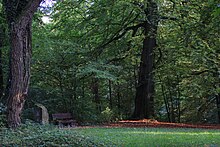Georgsplatz (Wennigsen)
The Georgplatz is a local position of the settlement Wennigser Mark the municipality Wennigsen . It forms a triangular valley meadow on the north-western edge of the Deister between the foothills of the Bröhn and the Suerser Brink . The area, which has been in use since early industrial times, is the oldest part of Wennigser Mark.
Hunting lodge
Georg place is after the Hanoverian King George V named. For him, a building ensemble was built as a hunting lodge in the south-west corner of the square in 1845. It includes three registered architectural monuments . The former royal forester's house from 1845 is located directly on the square.
King Ernst August I of Hanover had the house built as a hunting lodge by his court building director Georg Ludwig Friedrich Laves and the master mason Constantin Nordmann in 1845. He named it after his blind son Georg . The interior design was renewed by the painter Bolm from Hanover in 1909 and returned to its original state. Later, the forestry office of the Georgsplatz forestry department was housed in the castle . Today it serves as a residential building and is privately owned.
Toppius Square
On the Toppiusplatz in the Deister, directly opposite, there are two further registered monuments: the Toppius stone and the Lendorff monument. The square was the traditional gathering place for miners.
The square is located immediately southwest of Georgsplatz. It was laid out in terraces around 200 years ago. It used to be used to lay the hunting route. Even today, a Zackelschau is regularly held there, during which the thrown off antlers of the Deister deer are shown. The local community Wennigser Mark uses it for events such as the annual jazz morning pint or church services.
Toppius monument
The Toppius monument is intended to commemorate the royal court hunter Toppius, who was killed in a scuffle by a poacher. It was initially located further down by the trout pond and was moved to its current location in 1901. It is a stone about one meter high with the inscription:
- The memory of the royal Hunter's Toppius. Fatally wounded at this point in his profession on February 28, 1807, he died on the 2nd day in Wennigsen.
Lendorf monument
A stone around 1.20 meters high in memory of the royal woodworker Johann Dietrich Lendorf . The stone, which was subsequently moved here from Degersen , bears the inscription:
- To the celebration of the memory of Johann Dietrich Lendorf. Royal lumberjack over the Westerholz and the Suerserberg . Born on April 8, 1743 in Degersen, died there on November 30, 1815. His earthly shell rests in Wennigsen. Appreciated by his superiors, honored by his friends, he dedicated his impeccable life with restless activity to the protection and care of the forest. The honesty and loyalty during 44 years of service. His industrious witnesses shadow this memorial stone.
Business on Georgsplatz
In 1799, the last 1700 m long Bröhn tunnel for coal mining was built in the center of what will later be Georgsplatz. Field names such as machine house and smithy in the area southwest of the hunting lodge still indicate the location of the associated parts of the business.
In the 19th century Georg Egestorff operated a transshipment point at Georgsplatz for the coal extracted from his mines on Bröhn, Suerserbrink and Feldberg. To transport the coal in the direction of Hanover , Egestorff had the Deister- Kohlenstraße paved to Hamelner Chaussee . The material extracted from the quarry just west of Georgsplatz probably served as building material.
A pyrite mine was built in 1829 on the hilltop northeast of Georgsplatz . It belonged to a local fuse factory . It was later taken over by the Egestorff primer factory and operated until 1895. The Gauführerschule "Bernhard Rust" for the training of NSDAP officials was later built on the site . In 1963 the police training center for technology and traffic in Lower Saxony was established there.
To the east of Georgsplatz are the remains of several old Rottekuhlen by the trout stream . In 2009, several information boards about its historical use were set up along a two-kilometer path around Georgsplatz.
See also
literature
- Cornelia Kuhnert (text), Günter Krüger (photos): Georgsplatz. Mining and royal hunting , in this: 111 places around Hanover that one must have seen , [Cologne]: emons, 2015, ISBN 978-3-95451-707-7 and ISBN 3-95451-707-8 , p 216f.
Web links
Individual evidence
- ↑ Friedrich Wüllner. From Wennigsen's past. Contributions to local history . Wennigsen, self-published, 1973; P. 192
- ↑ Route 1 - From Bad Nenndorf to Wennigsen , www.hannover.de, accessed on September 12, 2011
- ↑ Wennigsen, Lendorf and Topius monument on Georgsplatz in Der Deister: Nature - People - History , Natural History Society Hanover, 2017, ISBN 978-3-86674-545-2 , p. 346.
- ↑ Wennigser Mark, Bröhn-Stollen in Der Deister: Nature - Human - History , Natural History Society Hanover, 2017, ISBN 978-3-86674-545-2 , p. 347/348.
- ^ Wennigsen, quarry in "Wealden" sandstone in Der Deister: Nature - Humans - History , Natural History Society Hanover, 2017, ISBN 978-3-86674-545-2 , p. 346.
- ↑ a b Wennigsen, Forsthaus Georgsplatz, sulfur gravel mine in Der Deister: Nature - People - History , Natural History Society Hanover, 2017, ISBN 978-3-86674-545-2 , p. 346/347.
Coordinates: 52 ° 15 ′ 55.8 " N , 9 ° 31 ′ 38.3" E






